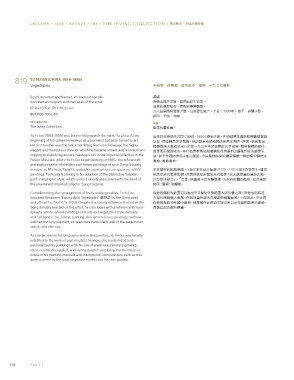Page 158 - Christie's Irving Collection Lacquer Bronse jade and Ink March 2019
P. 158
I
L A C Q U E R • J A D E • B R O N Z E • I N K T H E R V I N G C O L L E C T I O N 髹金飾玉 - 歐雲伉儷珍藏
819 YU FEI’AN (CHINA, 1888-1959)
Vegetables 于非闇 蔬果圖 設色紙本 鏡框 一九三七年作
Scroll, mounted and framed, ink and color on silk 題識:
Inscribed and signed, with two seals of the artist 野蔌山蔬次第嘗,超然氣壓太官羊。
放翁此意君知否,要配吳梗曉甑香。
27 √ x 15 æ in. (71 x 40.2 cm.)
元人蔬果圖有清逸之致,以沒骨法擬之。丁丑(1937年)嘉平,非闇于照。
$80,000-100,000
鈐印:于照、非闇
PROVENANCE
來源:
The Irving Collection. 歐雲伉儷珍藏。
Yu Fei’an (1888-1959) was born in Beijing with the name Yu Zhao. At the 出生於北京的于非闇(1888-1959)原名于照。在他職業生涯的初期曾經當過
beginning of his career, he worked as a journalist but soon turned to art. 記者,而後轉而追求藝術。他的啟蒙老師為民俗畫家王潤喧。然而,他高雅及
His frst teacher was the folk artist Wang Runxuan. However, the highly 精緻的個人風格是來自於從一九三五年起任職於北京故宮,臨摹館藏的歷代
elegant and meticulous style for which he became known was learned from 名畫而累積而成的。宋代名畫家馬遠和唐棣在花鳥題材上優雅巧妙的繪畫手
copying and studying ancient masterpieces in the imperial collection in the 法,從于非闇的作品中顯而易見。尤其是他師從宋徽宗獨創一格的瘦金體書法
Palace Museum, where Yu Fei’an began working in 1935. The refnement 風格,唯妙唯肖。
and sophistication of the bird-and-fower paintings of such Song-dynasty
masters as Ma Yuan, Tang Di, and other court artists are apparent in Yu’s 于非闇在此幅蔬果圖上,題了宋代詩人陸游(1125-1209)的《食野菜》。雖然
paintings. Particularly striking is his adoption of the distinctive “slender- 他深受宋代畫家影響,然而他在句末提及元代畫家「元人蔬果圖有清逸之致,
gold” calligraphic style, which is most closely associated with the hand of 以沒骨法擬之」。「沒骨」指繪畫中沒有輪廓線,而只有形體的顏色,如此畫的
the preeminent imperial collector Song Huizong. 柿子,蘿蔔,和櫻桃。
Complimenting this arrangement of fruits and vegetables, Yu Fei’an 從他的傳記和此畫可以看出于非闇受早期繪畫大師影響之深。但他也同時注
inscribed the poem “Eating Wild Vegetables” 食野菜 by the Song poet 入現代感與個人畫風。例如珠寶色調的深度調色與圖案感。不但如此,于非闇
and oficial Lu You (1125-1209). Despite the strong infuence that art of the 在他的題跋和手稿中提到,他是被住家附近市場以及自家花園的蔬果所啟發,
Song dynasty exerted on the artist, he concludes with a reference to Yuan- 而創造出這般的構圖。
dynasty artists, whose paintings of fruits and vegetables have delicacy
and “no bones”. In Chinese painting, this term refers to paintings without
outlines but only pigment, as seen here particularly well in the persimmon,
radish, and cherries.
As can be seen in his biography and in this painting, Yu Fei’an was heavily
indebted to the work of past masters. However, he modernized and
personalized his paintings with his use of jewel-like mineral pigments,
often extensively applied, and strong graphic sensibility. Furthermore, as
noted in his painting manuals and inscriptions, compositions such as this
were inspired by the local vegetable market and his own garden.
156 P A R T I

